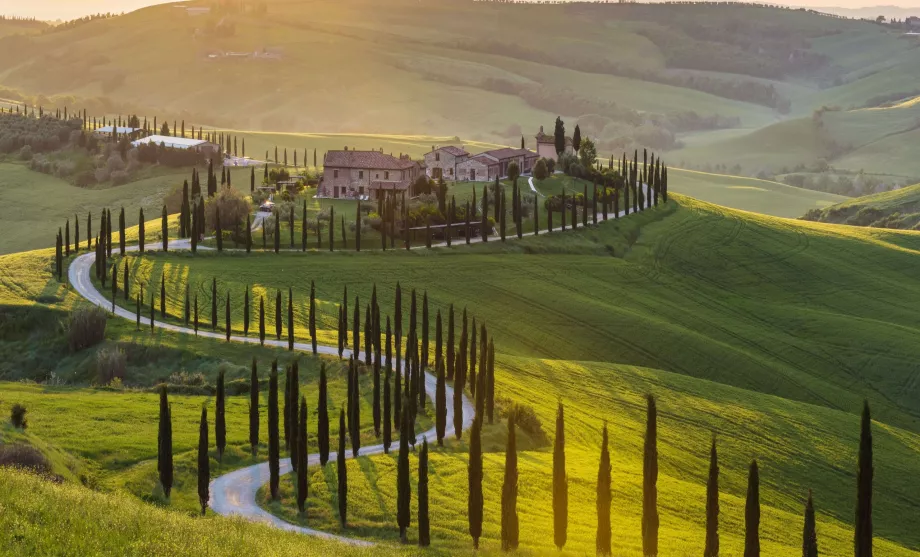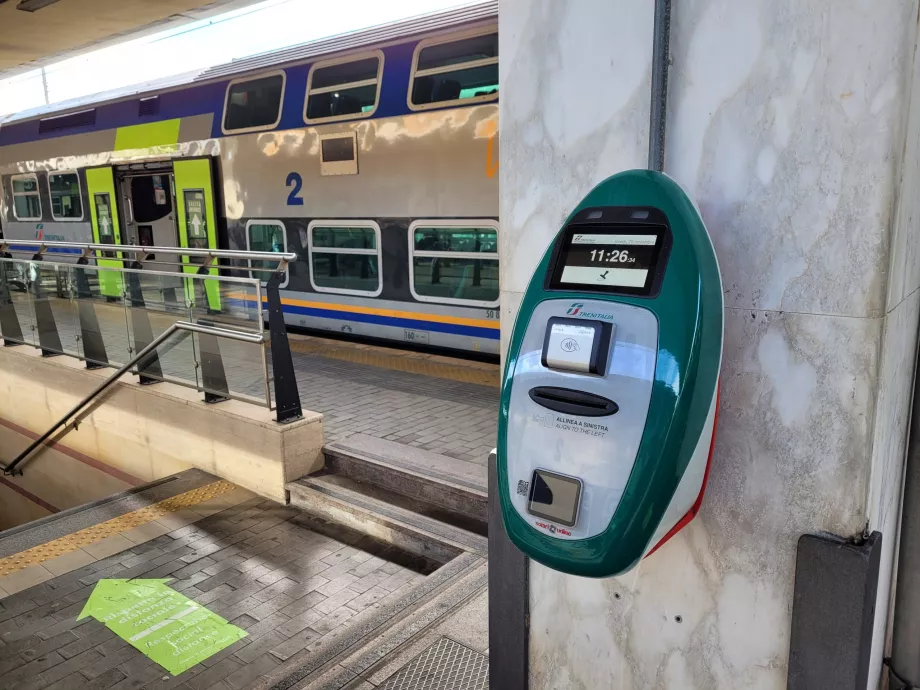Getting around Tuscany

When holidaying in Tuscany, you probably won't be able to get away with just staying in one city, so information on travel and transport in Tuscany will come in handy.
With good public transport and a relatively dense road network, you have plenty of choice.
Train
Travelling by train in Tuscany is the most comfortable, fastest and busiest transport option. At least if you're moving between major cities, which the vast majority of tourists will be.
In fact, you can really get to almost all the touristy places in Tuscany by train.
When moving purely around Tuscany, you will use the services of a single carrier, namely the state-owned Trenitalia.
Tickets and connection finder
You can find connections clearly and buy tickets directly online on the official trenitalia.com website; if you've used the popular thetrainline.com search engine when travelling in Europe, Trenitalia train tickets can also be bought there without a surcharge.
You can also use Trenitalia's easy-to-use mobile app to buy tickets and search for connections (Google Play / App Store), which is also available in English. Once you have purchased your ticket, all you have to do is show the QR code to the conductor on your mobile phone.
If you don't want to buy tickets in advance, it's no problem. To get around Tuscany, you can always make do with the local Regionale (R) or Regionale Veloce (RV), for which there is no need to buy tickets in advance (there are no seat tickets) and the price when bought at the station is the same as when bought in advance via the web/app.
The easiest way to pay for a ticket on regional connections is with your own contactless card. Simply attach it to the green and white reader on the platform before boarding the train and then when you get off the train.
There are machines at all stations where you can pay with cash and card, and you can also use ticket offices at the main stations.
Caution! Remember that you must always mark your ticket from the ticket machine or ticket office before boarding in the green and white markers located on the platforms.
Bus
To smaller villages, the bus is often the only transport option, but extensive bus networks can also be found in cities where public transport operates and as a suburban transport between large cities, conveniently complementing trains.
Finding information and timetables is very easy, as all urban, regional and intercity routes throughout Tuscany are covered by a single company, Autolinee Toscane.
Bus tickets - prices
So, on all routes throughout Tuscany, the same rules apply when travelling by bus and the same expensive tickets.
City lines
Everywhere there are only single tickets for a certain number of minutes. Within the time validity, you can change freely between buses or trams (in the case of Florence).
There are no all-day or multi-day tickets in any Tuscan city.
Public transport in the cities is divided into two categories with different prices.
- Capoluogo - the provincial capitals of Florence, Pisa, Arezzo, Carrara, Grosseto, Livorno, Lucca, Massa and the MIV system - the area of Pisa, Valdarno, Prato, Pistoia and Siena
- 1,70 eur - valid for 70 minutes, 90 minutes in Florence, must be purchased in advance at a newsagent, with your own contactless card inside the bus or via the mobile app
- 15,50 eur - Discounted price for a carnet of 10 tickets valid for 70 minutes or 90 minutes in Florence. Can only be purchased in advance at the ticket office or via the mobile app
- 3 eur - Ticket for 1 journey (not transferable) purchased in cash from the driver
- Maggiore - other towns with their own public transport, i.e. Cecina, Certaldo, Chianciano, Chiusi, Colle Val d'Elsa, Empoli, Follonica, Montecatini Terme, Montepulciano, Pescia, Piombino, Poggibonsi, Pontedera, Portoferraio, Rosignano, San Gimignano, Viareggio, Volterra
- 1,30 eur - valid for 70 minutes, 90 minutes in Florence, must be purchased in advance at a newsagent, with your own contactless card inside the bus or via the mobile app
- 12,20 eur - Discounted price for a carnet of 10 tickets valid for 70 minutes or 90 minutes in Florence. Can only be purchased in advance at the ticket office or via the mobile app
- 3 eur - Ticket for 1 journey (not transferable) purchased in cash from the driver
Intercity lines
On intercity and regional lines, fares are based on distance travelled. The prices are exactly according to the number of kilometres, for example:
- 1,70 eur - 0 to 10 km
- 2,90 eur - 10 to 20 km
- 3,90 eur - 20 to 30 km
- 5 eur - 30 to 40 km
- Full listing: at-bus.it/suburban
Where to buy a ticket
There are many ways to buy bus tickets.
With your own contactless card
The easiest way is to pay with a contactless card/mobile/watch in the form of Tap & Go.
- City lines - you only need to attach the card to the reader inside the bus when boarding.
- Intercity and regional lines - you must attach the card to the reader when boarding and before alighting
Via mobile app
Autolinee Toscane have a very clear mobile app for buying tickets.
Either you select a city ticket for 1,70 eur, or 1,30 eur or for intercity routes you select the point of departure and destination.
Download the AT BUS mobile app.
Tickets for Tuscan buses can also be bought via the slightly less clear Tabnet app.
Paper tickets
Classic paper tickets for city and intercity services can be purchased from many retailers, mostly in newsagents, bars, restaurants or grocery stores.
For a complete list of retailers, see this page: at-bus.it/en/retailers.
From the driver
You can also buy a ticket directly from the driver, but you can only pay in cash.
For intercity and regional lines, the price is the same as when you buy with your own contactless card or via mobile apps, but for urban lines the price is higher at 3 eur per ride.
Timetables and routes
You can find clear timetables on the at-bus.it website. You can search either by line number (note that the same number can have multiple lines running in different locations - especially for urban lines) or by region.
How can I find out which line goes through a particular stop? Google Maps doesn't show the Autolinee Toscane intercity stops, but for example our popular website mapy.cz will show you all the line numbers that pass through a given stop when you click on the bus icon.
On the at-bus.it website you will always find different categories of lines:
- Urbano = city lines
- Capoluogo - large cities with more expensive fares
- Maggiore - small towns with cheaper fares
- Extraurbano = intercity lines
- Regionali = long intercity lines between major cities
How to read timetables?
On the at-bus.it website, you can select a specific stop on a given line from the list and then the next departure times will be displayed, along with the destination.
You can also view the timetable in pdf format.
- Feriale = working day, which in Italy means Monday to Saturday
- Feriale escluso Sabato = working day except Saturday, so the timetable marked as such is valid only for Monday to Friday
- Sabato = the timetable is valid for Saturday only
- Festivo = timetable valid only for Sunday and public holidays
Note that on Sundays and public holidays in particular, there are very few or no buses to the countryside. Many routes run only from Monday to Saturday.
However, city buses and lines to important tourist towns also run on Sundays.
By car
If you want to travel to the Tuscan countryside to small villages where buses are quite irregular, consider travelling by car. Especially on Sundays and public holidays, buses to smaller villages run very little or not at all.
If you are not travelling by your own car, then there is nothing easier than hiring a car from a car rental company upon arrival.
For detailed information on rental prices, as well as traffic regulations or motorway tolls, see the chapter - Car rental Tuscany.
Ferries to the Tuscan islands
We describe the regular boat lines from Tuscany to abroad or other Italian regions in the chapter How to get here.
Find out all about ferries from the mainland to other Tuscan islands in this chapter.
Elba
The largest island is served by many large boats carrying foot passengers and cars.
| Route | Price - pedestrian | Price - car | Frequency | Sailing time |
|---|---|---|---|---|
| Piombino - Portoferraio | from 14 eur | from 47 eur | 2-4 times per hour | 40 to 60 minutes |
| Piombino - Rio Marina | from 20 eur | from 69 eur | 4-8x daily | 45 minutes |
| Piombino - Cavo | from 24 eur | from 67 eur | 5x daily | 15 minutes |
Book your ferry on directferries.com
Giglio
The island of Giglio, infamous for the Costa Concordia disaster, can be reached by ferry from the Monte Argentario peninsula.
The boats sail only from the port of Porto Santo Stefano.
- Price 20 eur for a pedestrian one way / 83 eur for a car
- Cruise time 1 hour
- Ferry sails 4-5 times a day
- Book on directferries.com
Capraia
You can reach the beautiful island of Capraia by ferry from the port of Livorno.
- Price 30 eur for pedestrians one way
- Sailing time 2 hours 45 minutes
- Ferry sails 1-2 times a day
- Book on directferries.com
Giannutri
A small island with no roads, Giannutri attracts mainly easy walking routes and little-visited beaches.
A one-way ticket costs from 13 eur to 15 eur depending on the season and the boat sails 3 times a day in high season from the port of Porto Santo Stefano.
Timetables and online ticket booking: maregiglio.it/orari.
Gorgona
Regular ferries run to this picturesque hilly islet off the port of Livorno.
A one-way ticket costs 15 eur depending on the season and the boat sails twice a day in high season.
Timetables and online ticket booking: toscanaminicrociere.it.
Any questions left?
If you have any questions or comments about the article...



